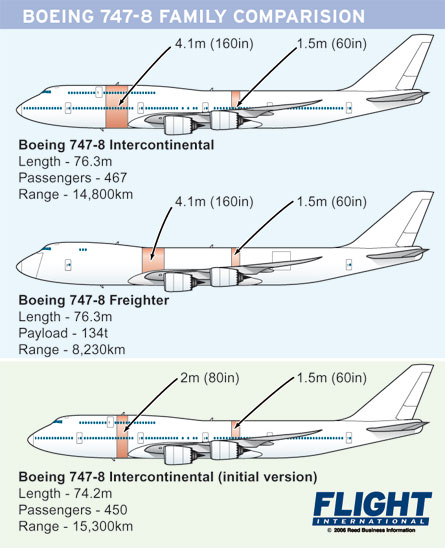& Guy Norris in Los Angeles
Boeing opts for larger passenger variant but Dubai airline would rather see it build original longer-range proposal
Boeing is facing a potential dilemma with its 747-8 family planning following its decision to adopt the -8 freighter's longer fuselage for the -8I passenger variant. Although the increased seating capacity of the revamped -8I is favoured by a number of airlines, one key potential customer - Emirates - would prefer Boeing to build the shorter, longer-range variant it originally proposed.
The original 74.2m (243ft)-long 747-8I unveiled last November could typically carry 450 passengers in a three-class layout over a range of 15,300km (8,270nm), whereas the new larger variant now adopted will seat 467 passengers and has a range of 14,800km (see graphic).
The decision to adopt the longer stretch is understood to have been driven by a core of potential airline customers favouring the design. Sources say that British Airways, which is evaluating the 747-8I along with the Airbus A380, has been a strong proponent of the longer model and does not need the extra range offered by the original proposal.

But the decision has not met with the approval of Emirates, says the airline's president Tim Clark. "We have made it clear to Boeing that we prefer the [original] stretch because of its greater range at maximum payload," he says, adding that he has suggested to Boeing that it should consider building both versions "to increase the product spread within the family". Boeing has said previously that it intends to build only one version of the 747-8I, but says despite now settling on the length, it is "still in discussions with airlines about what the optimal performance is for the -8I from an operating cost and economics perspective".
Emirates has ordered up to 20 747-8Fs for its cargo arm, and is evaluating the -8I for its passenger fleet to slot in between its 360- to 430-seat 777-300ERs and 490- to 640-seat A380s. Due to its network and Dubai location, it usually sets challenging performance rules for the manufacturers.
Boeing says performance predictions for the new 747-8I indicate that, even with the rules adopted by most carriers, the aircraft will be capable of a "normal range" of 14,800km - giving it the legs for marginal routes such as Dubai to Los Angeles. Routes such as Mumbai to Los Angeles, a great circle length of 14,100km, are "well within" its capabilities, it adds.
Boeing acknowledges, however, that "every airline has its own rules, and some are more stringent than others" and Clark says that under Emirates rules the new -8I will not do Dubai-Los Angeles "with a meaningful payload".
Boeing does not rule out studies of auxiliary fuel versions for range-challenged carriers, but says "right now the focus is on how to get the lowest operating costs and the best economics while fulfilling a normal range of 8,000nm".
| Final configuration of the 747-8I is due to be frozen in mid-2007, with initial deliveries in mid-to-late 2010. Boeing originally hoped to kick off deliveries as early as April 2010, but appears to have delayed the date by a few months as it ramped up recent efforts to secure solid commercial launch orders. The later date is still less than a year after the first -8F freighters are due to begin delivery in October 2009. Based on Boeing's standard tri-class layout, the new baseline now increases first-class seating to 25, two more than the -400 and one more than the original 74.2m (243ft)-long -8I, while business class accommodation rises to 89 against 80/85, respectively. The largest rise is in economy class, which grows to 353 seats against 313 in the -400 and 341 in the original -8I configuration. These numbers do not reflect the additional main deck seating area that can be freed by moving the aft galleys up to the newly opened up SkyLoft areas. |
|---|
Source: Flight International



















